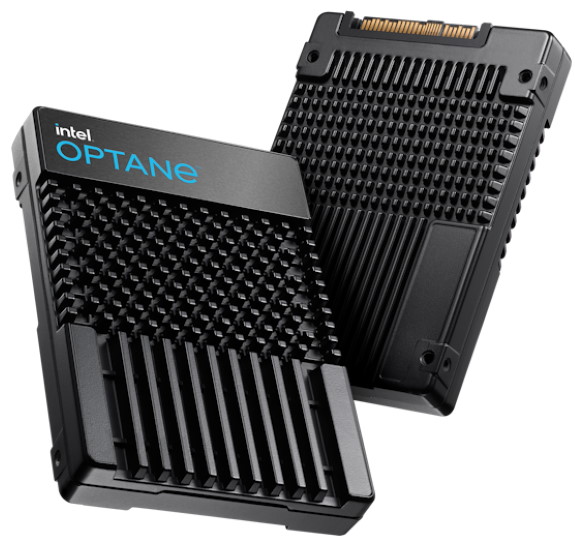
First up, Intel has the SSD 670p, this is a new consumer SSD that uses 144-layer QLC NAND flash memory. The 670p uses a new controller but remains PCI Express 3.0 based. There will be 512GB, 1TB, and 2TB editions. Intel optimized the SLC cache system to ensure better performance in real-world usage for partially-filled disks. The SSD 670p will be out in Q1 2021.
Optane for the consumer market seems largely abandoned. Intel has various new models for the datacenter market but the only product for consumers is the Optane Memory H20, which is an M.2 PCI Express 3.0 card that combines 512GB or 1TB of 144-layer QLC NAND with 32GB of Optane memory. It's exclusively aimed at laptops and should be out in Q2 2021.
What's New: Today, at Intel's Memory and Storage 2020 event, the company highlighted six new memory and storage products to help customers meet the challenges of digital transformation. Key to advancing innovation across memory and storage, Intel announced two new additions to its Intel® Optane™ Solid State Drive (SSD) Series: the Intel® Optane™ SSD P5800X, the world's fastest data center SSD, and the Intel® Optane™ Memory H20 for client, which features performance and mainstream productivity for gaming and content creation. Optane helps meet the needs of modern computing by bringing the memory closer to the CPU. The company also revealed its intent to deliver its 3rd generation of Intel® Optane™ persistent memory (code-named "Crow Pass") for cloud and enterprise customers.The Optane SSD P5800X is pictured below.
"Today is a key moment for our memory and storage journey. With the release of these new Optane products, we continue our innovation, strengthen our memory and storage portfolio, and enable our customers to better navigate the complexity of digital transformation. Optane products and technologies are becoming a mainstream element of business compute. And as a part of Intel, these leadership products are advancing our long-term growth priorities, including AI, 5G networking and the intelligent, autonomous edge." –Alper Ilkbahar, Intel vice president in the Data Platforms Group and general manager of the Intel Optane Group
What Else Intel Announced: Intel also announced three new NAND SSDs featuring 144-layer cell memory: the Intel SSD 670p, the company's next-gen144-layer quad-level-cell (QLC) 3D NAND SSD for mainstream computing; the Intel SSD D7-P5510, the world's first-to-market 144-layer triple-level-cell NAND design; and the Intel SSD D5-P5316, a greater-density, higher-endurance SSD built around the industry's first 144-layer QLC NAND.
Why Intel Optane Technology Matters: With today's Intel Optane technology announcements, Intel continues to establish a new tier in the data center memory and storage pyramid, which combines the attributes of both DRAM and NAND. Intel Optane SSDs alleviate data supply bottlenecks and accelerate applications with fast caching and fast storage to increase scale-per-server and reduce transaction costs for latency-sensitive workloads.
Intel Optane persistent memory is Intel's vision of a memory and storage solution that offers persistence, capacity, affordability, low latency and memory-like speed. With Intel Optane persistent memory, Intel has re-architected the memory and storage hierarchy allowing it to be used as a distinct capacity and performance tier for memory and storage. With this approach, it is possible to create a two-tiered memory architecture where DRAM is the performance tier and persistent memory is the capacity tier. In the case of storage, Optane persistent memory is used as the performance tier to the NAND capacity tier.
Intel Optane persistent memory is attached to the CPU via the double-data rate bus, enabling direct load-and-store access at DRAM speeds; non-volatile, it combines the best elements of memory and storage.
Intel will further strengthen and extend its unique memory and storage portfolio with its 3rd generation of Intel Optane persistent memory, code-named "Crow Pass" and in future Intel® Xeon® Scalable processors (code-named "Sapphire Rapids.")
Why 144-layer cell memory NAND Matters: Three new NAND SSDs announced today represent new milestones for establishing TLC and QLC as a mainstream technology for high-capacity drives. The Intel® 3D NAND SSD 670p is Intel's next-gen 144-layer quad-level-cell (QLC) 3D NAND SSD for mainstream computing. The Intel SSD D7-P5510 is the world's first-to-market 144-layer TLC NAND design and the Intel SSD D5-P5316 is built around the industry's first 144-layer QLC NAND. Intel has been developing these technologies over the past decade.
